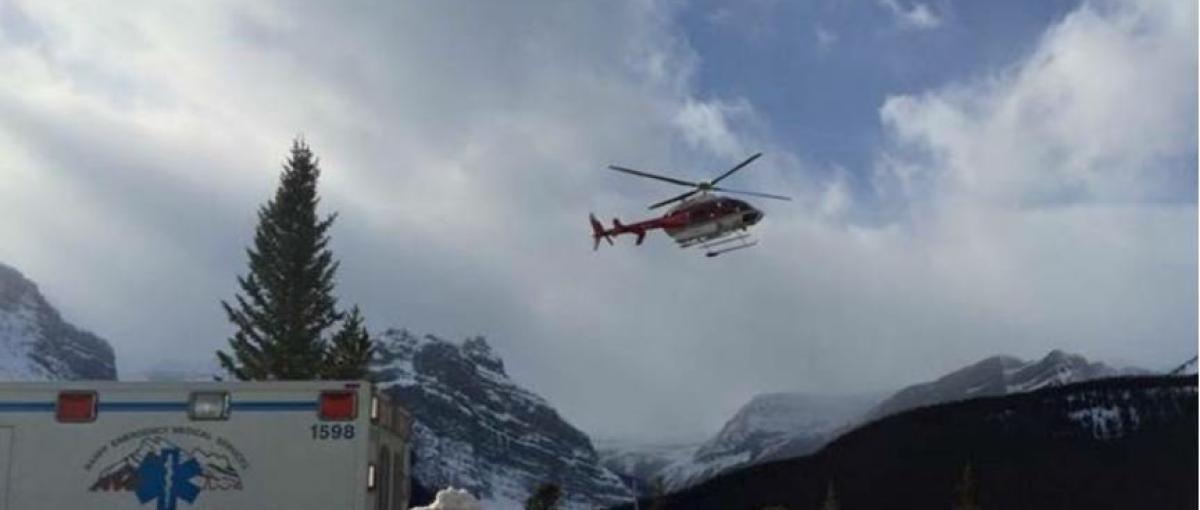Emergency response in a mountain town
Banff Hospital’s emergency medical teams deal with high levels of patient trauma, long distances and backcountry rescue

March 21, 2018
By Tessia Verbeek
Every year, millions of visitors flock to Banff to explore, sightsee and relax. For the vast majority, the visit goes as planned. But a few will need the services of Banff’s Emergency Medical Services (EMS) team.
Banff Mineral Springs Hospital is the only Covenant Health facility with its own EMS team, which provides emergency services to tourists as well as the 13,000 residents who call this picturesque area home. These paramedics and emergency medical technicians (EMTs) make up one of the most specialized and skilled EMS teams in the province to deal with high levels of patient trauma, long distances and backcountry rescue.
Banff’s team sees accidents and injuries that are unusual for urban centres.
“From animal and vehicle accidents, to complex mountain rescues, avalanches and extreme weather, it’s not your average day for most medics,” says Patti McFadyen, Manager of Surgical Services at Banff Mineral Springs Hospital.
Banff’s paramedics share their stories, in their own words.
Stuart Paterson
Paramedic with Banff Mineral Springs Hospital for 10 years
When we're working, we keep our personal mountain travel equipment in the ambulance. Boots, crampons, puffy jackets, food and water, things we would need for extended backcountry calls. Banff's amazing natural environment offers engagement for all sorts of adventure seekers and sometimes they need help. We respond throughout Banff, Lake Louise, Kootenay and Yoho national parks for people in need of medical assistance. Usually, they're in the town sites or on the highway, but sometimes they're a little harder to get to.
The Ghost River Valley on the border of Banff National Park is a popular rock and ice climbing destination. It’s a two-hour drive from Banff. A couple of winters ago, I was called to attend to an ice climber who had fallen. I joined Parks Canada and Kananaskis Visitors Safety Specialists to rescue the patient from where he lay. A one-and-a-half-hour bushwhack and an ice climb led to the patient, who had suffered a pelvic fracture in the fall. After assessing and stabilizing him, the team was ready for a short lower and then the slog through the forest to a clearing large enough to accommodate the STARS crew, who were on standby to transport him to the Calgary trauma centre. It was an excellent example of our collaborative approach to managing illness and injury.
While this job has the potential to be stressful, we are well supported and prepared. We are constantly learning and finding new ways to delivery critical care to those in need, regardless of where they find themselves.
Andrew Young
Paramedic with Banff Mineral Springs Hospital for 15 years
My university studies were in kinesiology, but I’ve worked wildland and structure firefighting and managed a bike and kayak shop. I’ve spent most of my life in the mountains skiing and climbing, originally working towards being a mountain guide. My diverse experience helps me to see the big picture, which is useful when we’re managing our resources across multiple incidents, calls and agencies.
Banff is a small community, and our healthcare community is even smaller. Last November, I was off duty, volunteering with the World Cup races at Lake Louise. A man collapsed at an evening social function. He had gone into anaphylactic shock after accidentally eating seafood, and being asthmatic complicated his medical care.
The overseeing physician with the races and I took over care, but all we had was the hotel first aid kit and eventually, the fire department’s basic life support kit. Without the proper tools, we were jerry-rigging until the ambulance arrived. We intubated the patient right there on the floor of the lobby.
The ambulance arrived and after 40 minutes of basic life support, we were able to stabilize the patient and transfer care to STARS. It was a great example of a close-knit healthcare community coming together to provide excellent care for a good outcome. He was discharged 48 hours later.
Liese Bielby
Paramedic with Banff Mineral Springs Hospital for two years
We are a rural service with a small crew, which can be difficult when there are multiple calls.
One of my most memorable calls was during my practicum. The patient was experiencing a severe diabetic emergency. We transported the patient to the hospital but then received another call to the ski hill. The last I heard of the patient was that he was evacuated by STARS ambulance.
This past spring, I dropped my Husky off at doggy daycare and got to talking with the new owner. What do you know, not only was he a STARS survivor, but the patient from 2015! It was great getting to hear the rest of his story. That’s the part we rarely get to hear.
People are sometimes scared of their situation when they first meet me, which is why I work to build rapport.